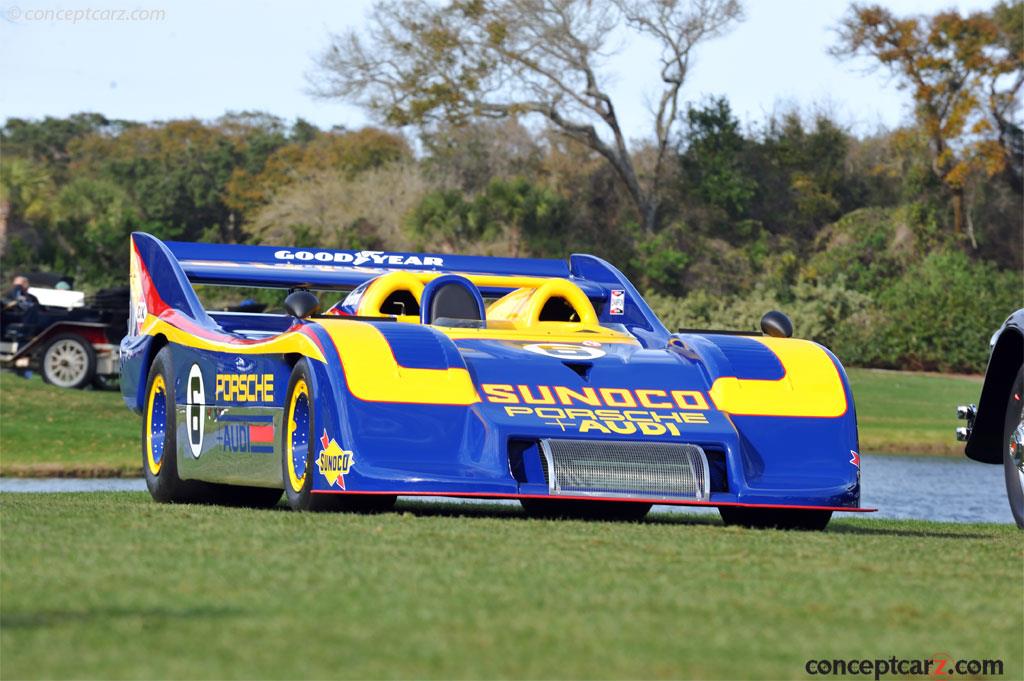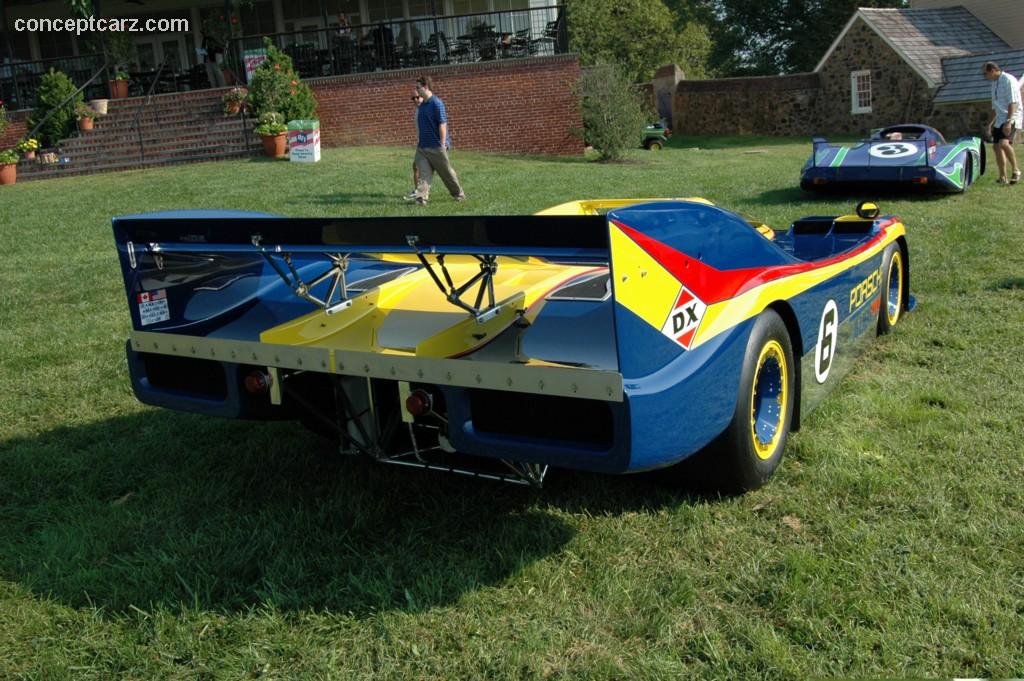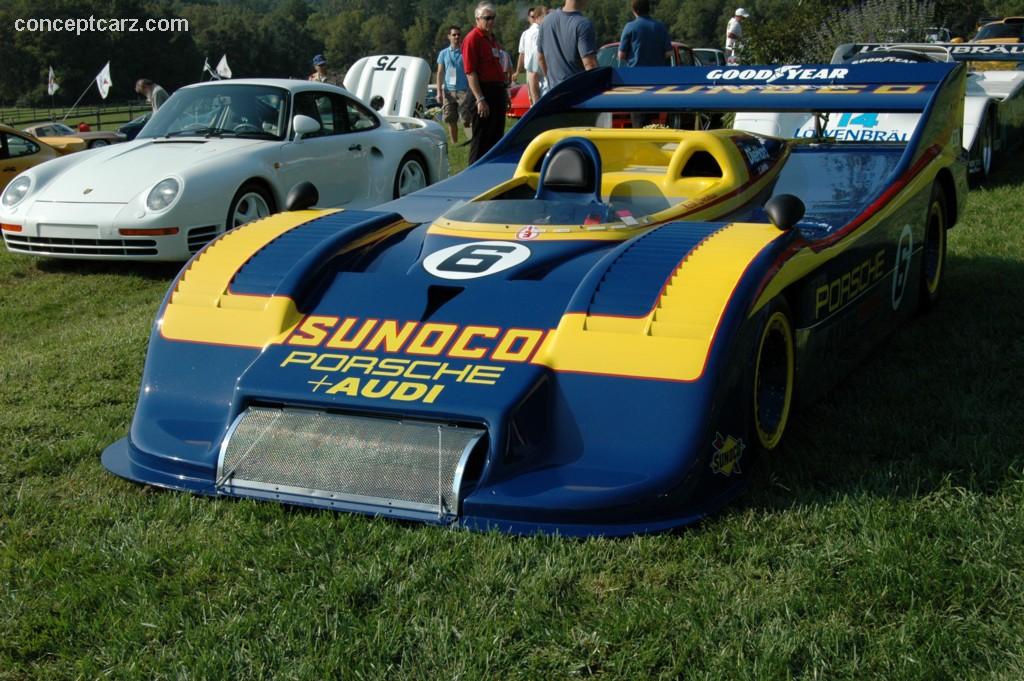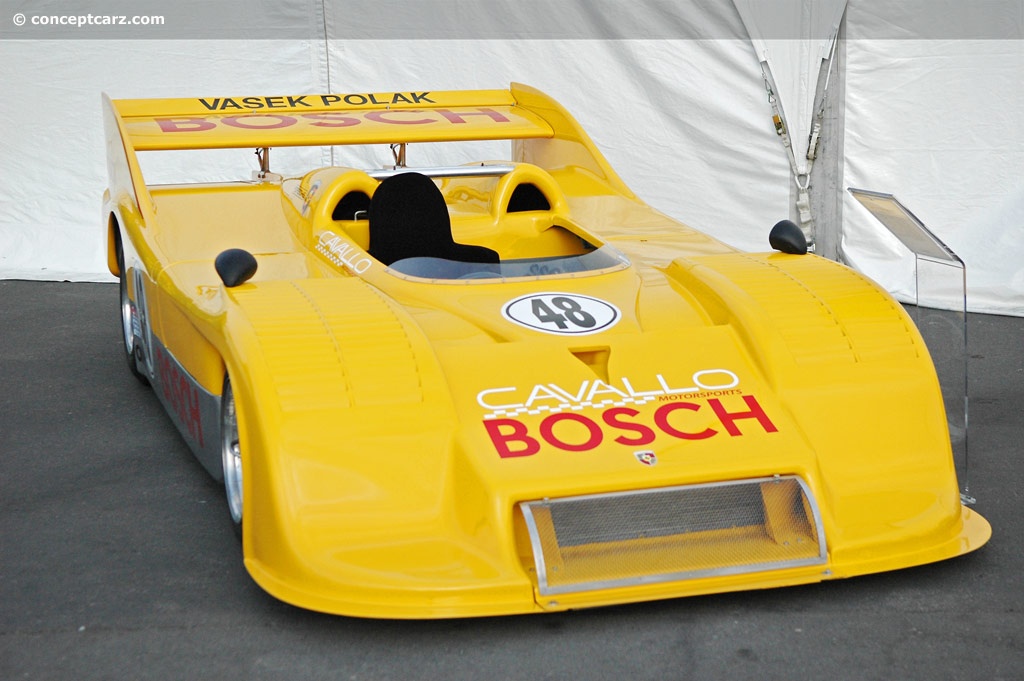The Porsche 917 was the final step in the progression of the new era of Porsche racing cars that began with the 906 in 1966. In 1969, the three-liter engined 908 won the World Championship, but Porsche feared it would never have the adequate horsepower to claim overall honors at Le Mans, a goal as important for Porsche as winning the World Championship, against the Lola T70s, Ford GT40s, and the upcoming McLaren Group 4 coupe. 
Sports Racer
Chassis #: 917/30-003
View info and historyThe Automobile Club de l'Ouest (ACO) introduced several new regulations at the end of the 1968 racing season aimed at reducing average speeds. Cars eligible to compete for the World Manufacturers' Championship were exotic racing cars built in small numbers, three-liter prototypes, and Group 4 five-liter sports cars constructed in a series of 25 identical examples (down from 50). With the reduced homologation requirements, the Porsche factory seized the opportunity and the five-liter 917 was born, intending to campaign it alongside the three-liter 908. Porsche's new five-liter car was built in keeping with Porsche tradition and employed the most modern concepts in automotive design. Beginning with the 908 chassis, the 12-cylinder, aluminum space-frame 917 made extensive use of lightweight materials, including magnesium and titanium. The body was formed from thin fiberglass and fitted with NACA ducts and suspension-controlled aerodynamic flaps. The shape was honed and perfected in the wind tunnels at Stuttgart Technical Institute, and each car was designed to wear both short and long tails, the latter specially designed for the high-speed LeMans' Mulsanne Straight. The air-cooled flat 12-cylinder engine, designed by Hans Mezger, was given dual overhead camshafts, Bosch mechanical fuel injection, mechanical driven six-blade fan, dry-sump lubrication, and twin-plug ignition. In its original 4.5-liter form, the engine delivered 580 horsepower at 8,400 RPM. 
Sports Racer
Chassis #: 917/30-004
View info and history
Auction entries : 2The new car, named the 917, was unveiled at the Geneva Auto Show in March 1969. 25 completed 917s were staged by Porsche in a perfect row in the courtyard outside Werk I to greet the inspectors sent by the International Sporting Commission (CSI) of the FIA, on Monday, April 21st. Success and perfection were far from immediate, as the 917 quickly gained the nickname 'the Ulcer' by works driver Gerhard Mitter. Vic Elford stated that 'the early 917 really was virtually undrivable.'Work, development, and testing continued throughout the 1969 season; by 1970, the improved 917K (K was for Kurz, or 'short') was ready for competition. It would claim back-to-back victories at the 24 Hours of LeMans during the 1970 and 1971 seasons, and Porsche won its second and third Manufacturers' Championship. Porsche won every championship race on the calendar for two years, except for Sebring which was won by Scuderia Ferrari, and three victories by the Alfa Romeo Autodelta team. 
Sports Racer
Chassis #: 917/30-004
View info and history
Auction entries : 2The 917 had elevated Porsche from being a class winner to an overall winner in the sport's highest level of competition. Including the two years in turbocharged Can-Am specification, the 917K firmly established itself as the ultimate sports racing car of the era. The 917 won more races in the Manufacturers World Championship, Can-Am, and Interserie than any other two-seater race car ever built. Victories include the Le Mans 24 Hours, Sebring 24 Hours, Daytona 12 Hours, 1000 Kilometres at Monza, Spa, and the Nürburgring.CanAm : The 917/10
With about half the Porsche car production being sold in the United States, this was a very important market. To showcase Porsche's ability, the German company selected the prestigious North American Can-Am Challenge racing series. By 1969, they had designed and tested the first open 917 cars for the 'no limit' Can-Am Series. In Europe, the coupe-bodied 917 became ineligible to compete in the world championship after 1971, prompting Porsche to focus on the Group 7 class, including the European Interserie and the North American Can-Am Challenge racing series. The North American market was very important, as about half the Porsche car production was sold in the United States. The 917 and 908s had been competing in the CanAm series by privateers since 1969, but with limited factory support. This changed when Porsche announced the arrival of the purpose-built Group 7 car of 1971, the Porsche 917/10. Although mechanically similar to the coupe version, it was fitted with a number of features that would take full advantage of the 'wide open' CanAm series. Lightweight exotic materials were used throughout the vehicle, a larger fuel tank was added for the endurance races, and new spyder bodywork was installed. The flat-12 cylinder engine was initially underpowered compared to the 800+ horsepower all-alloy Chevy V8s, so Porsche closed the gap with the help of twin turbochargers.
Sports Racer
Chassis #: 917/30-004
View info and history
Auction entries : 2The use of turbos presented Porsche with several obstacles to overcome, including throttle lag which required turbines inside the turbocharger to operate at a specific speed. When the turbochargers were fully engaged, the drivers were greeted with an immediate increase in power, which was either helpful or detrimental. With over 900 horsepower in peak form, the 917/10 was a difficult beast to tame and was more than adequate to beat the McLarens during the 1972 CanAm season. Penske Racing's 917/10, driven by George Follmer, won six of the nine races to claim the Driver's Championship.The Ultimate Version of the Ultimate Sports Racing Car : the 917/30
Penske Racing was a young team in the early 1970s, having entered the racing scene in the late 1960s. Although inexperienced, they were influential and very successful in a number of racing arenas. The Newton Square, PA-based team, with L&M Cigarette sponsorship, had dominated the 1972 Can-Am season. For the following season, they worked with Hans Mezger's team to further the 917/10, resulting in the 917/30 of 1973. Compared to its predecessor, it was an all-new car powered by an enlarged 5.3-liter flat 12-cylinder, turbocharged engine. The wheelbase was extended, the lower wishbones were strengthened, new low-drag bodywork was added, and special extractor turbines for the wheels were developed to aid in brake cooling. With an overall weight of 1,765 lbs and horsepower surpassing 1,200 hp, the 917/30 was capable of zero-to-sixty mph times in 2.1 seconds. 0-100 mph was accomplished in 3.9 seconds and 0-200 was done 13.4 seconds. The top speed was over 240 mph if there was adequate real estate.
Sports Racer
Chassis #: 917/30-004
View info and history
Auction entries : 2Charlie Kemp won the first round, at Mosport, in the 917/10, and George Follmer won the second event, at Road Atlanta, in another 917/10. For the rest of the season, Mark Donohue and his 917/30 won the remaining six rounds and captured the Can-Am Championship. 'At this time there is nothing in the world any quicker, and better handling, any more advanced technically, or any more fun to drive. It is, to me, the perfect race car,' Donohue said that year. At the end of the 1973 season, Donohue and Porsche announced their retirement from the Can-Am program. Donohue would make one final appearance with the 917/30, in 1975, breaking the closed-course speed record held by A.J. Foyt's Coyote USAC car with a lap of Talledega's high-banked oval at 221.120 mph. The record stood for almost two decades.Six examples of the 917/30 were built with three never raced in period. Chassis number 001 was built with an adjustable chassis allowing it to be tested in a variety of configurations. After extensive testing, the two Penske cars were built (chassis 002 and 003). Chassis number 002 earned the team its first victory of the season, at Watkins Glen, but after a crash, Donohoue switched to chassis 003. Donohoue and 003 would win at Mid-Ohio, Road America, Edmonton, Laguna Seca, and Riverside. This was also the car Donohue used to set the high-speed record at Talladega in 1975. 
Sports Racer
Chassis #: 917/30-006
View info and historyChassis number 004 went to the Australian Porsche importer Alan Hamilton, and chassis 005 and 006 were never completed 'in period.'
by Daniel Vaughan | Apr 2020

Sports Racer
Chassis #: 917/30-003
View info and history

Sports Racer
Chassis #: 917/30-004
View info and history
Auction entries : 2

Sports Racer
Chassis #: 917/30-004
View info and history
Auction entries : 2
With about half the Porsche car production being sold in the United States, this was a very important market. To showcase Porsche's ability, the German company selected the prestigious North American Can-Am Challenge racing series. By 1969, they had designed and tested the first open 917 cars for the 'no limit' Can-Am Series. In Europe, the coupe-bodied 917 became ineligible to compete in the world championship after 1971, prompting Porsche to focus on the Group 7 class, including the European Interserie and the North American Can-Am Challenge racing series. The North American market was very important, as about half the Porsche car production was sold in the United States. The 917 and 908s had been competing in the CanAm series by privateers since 1969, but with limited factory support. This changed when Porsche announced the arrival of the purpose-built Group 7 car of 1971, the Porsche 917/10. Although mechanically similar to the coupe version, it was fitted with a number of features that would take full advantage of the 'wide open' CanAm series. Lightweight exotic materials were used throughout the vehicle, a larger fuel tank was added for the endurance races, and new spyder bodywork was installed. The flat-12 cylinder engine was initially underpowered compared to the 800+ horsepower all-alloy Chevy V8s, so Porsche closed the gap with the help of twin turbochargers.

Sports Racer
Chassis #: 917/30-004
View info and history
Auction entries : 2
Penske Racing was a young team in the early 1970s, having entered the racing scene in the late 1960s. Although inexperienced, they were influential and very successful in a number of racing arenas. The Newton Square, PA-based team, with L&M Cigarette sponsorship, had dominated the 1972 Can-Am season. For the following season, they worked with Hans Mezger's team to further the 917/10, resulting in the 917/30 of 1973. Compared to its predecessor, it was an all-new car powered by an enlarged 5.3-liter flat 12-cylinder, turbocharged engine. The wheelbase was extended, the lower wishbones were strengthened, new low-drag bodywork was added, and special extractor turbines for the wheels were developed to aid in brake cooling. With an overall weight of 1,765 lbs and horsepower surpassing 1,200 hp, the 917/30 was capable of zero-to-sixty mph times in 2.1 seconds. 0-100 mph was accomplished in 3.9 seconds and 0-200 was done 13.4 seconds. The top speed was over 240 mph if there was adequate real estate.

Sports Racer
Chassis #: 917/30-004
View info and history
Auction entries : 2

Sports Racer
Chassis #: 917/30-006
View info and history
by Daniel Vaughan | Apr 2020
1973 Porsche 917/30 Vehicle Profiles
Recent Vehicle Additions
Related Automotive News

1929 Duesenberg J-218 Town Limousine And 1973 Porsche 917/30 Can-Am Spyder Named Best In Show At The 25Th Annual Amelia Island Concours d'Elegance
Jacksonville, FL - A 1929 Duesenberg J-218 Town Limousine and 1973 Porsche 91730 Can-Am Spyder were crowned this years Best in Show on March 8, 2020 at the 25th annual Amelia Island Concours dElegance. In celebration of the events Silver Anniversary,...

One of World's finest competiton car collections to be sold at RM's Paris sale
RM Auctions announces stunning Harburg Collection for its debut Paris sale, 4–5 February 2014
Collection boasts a number of highly significant Porsche models, including a 1973 ex-Works 91730 Can-Am Spyder, a 1982 ex-Works 956 956 Group C Sports-...

Can-Am History Roars Back to Life at Spring Classic May 19-21
The Can-Am Series made its last appearance at Mazda Raceway Laguna Seca at the 1973 Monterey Grand Prix. Vic Elford (10) in the UOP Shadow was chased through the Corkscrew by winner Mark Donohue (6) in the dominant Sunoco Porsche 91730.
MONTEREY,...
Vintage Racers Decend on Road America for The WeatherTech International Challenge With Brian Redman Presented by HAWK
- Mid-Summer Vintage Event Recalls a Sensational Era of Racing -
ELKHART LAKE, Wis., July 12, 2016 - Summer is in full swing and this year hundreds of vintage racers will make the journey to Elkhart Lake, Wisconsin to celebrate the beauty...

Sonoma Historic Motorsports Festival Celebrates Can-Am at Sonoma Raceway
More than 350 vintage and historic race cars highlight May 17-18 weekend
George Follmer and Don Nichols are honored guests popular racing seminar set for third year
SONOMA, Calif. (May 7, 2014) - The Sonoma Historic Motorsports...
RRDC VOTES IN 37 NEW MEMBERS FOR 2013
HILLIARD, Ohio (Nov. 7, 2013) - Thirty-seven race-car drivers and motorsports professionals have been voted into the Road Racing Drivers Club in 2013. The group includes 13 Regular Members from the open-wheel and sports-car racing ranks, 20 Associate...

1967 Can-Am Road America: The Beginning of the 'Bruce and Denny Show'
While Formula One will be forever considered the pinnacle of motorsport, from a period between 1966 and 1986 there existed a series that would likely be the closest to anything goes as any motor racing series could truly get. Based upon the FIA Group...









































